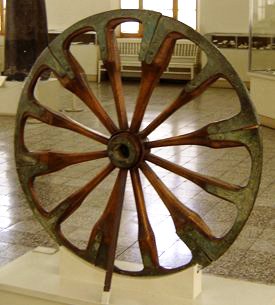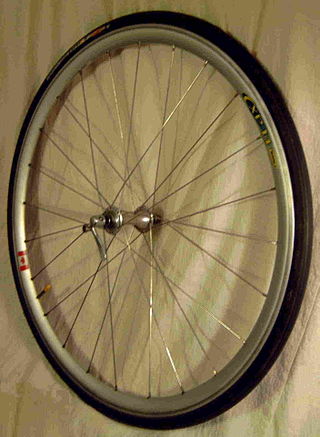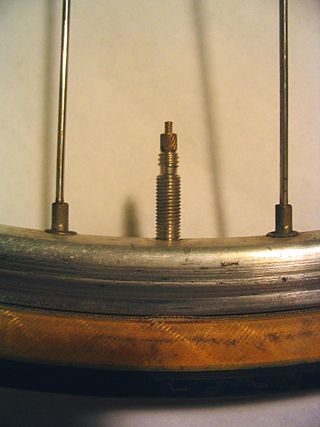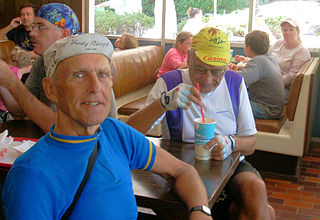 First edition | |
| Author | Jobst Brandt |
|---|---|
| Country | United States |
| Language | English |
| Published | 1981 |
| Media type | |
| Pages | 150 |
| ISBN | 0-9607236-2-5 |
The Bicycle Wheel is a treatise on wheelbuilding by Jobst Brandt first published in 1981.
 First edition | |
| Author | Jobst Brandt |
|---|---|
| Country | United States |
| Language | English |
| Published | 1981 |
| Media type | |
| Pages | 150 |
| ISBN | 0-9607236-2-5 |
The Bicycle Wheel is a treatise on wheelbuilding by Jobst Brandt first published in 1981.
The Bicycle Wheel is an educational book that explains the structural theory of a wire wheel, and teaches the practical methodology of building bicycle wheels. [1]
The book is made up of three parts. Part one, "Theory of the Spoked Wheel", examines how a wire wheel supports various loads, what causes wheel failure, what aspects of a wheel confer strength and durability, discusses each of the individual components that make up a spoked wheel, and examines wheel design. Part two, "Building and Repairing Wheels", explains how to select components, how to build a wheel, and how to repair various forms of damage. Part three, "Equations and Tests", provides a mathematical analysis of spoked wheels. [2]
The Bicycle Wheel is considered by many to be the premier resource on building bicycle wheels. Noted bicycle mechanic and technical expert Sheldon Brown called it "the near-definitive text on the theory and practice of building spoked bicycle wheels". [3]

A bicycle, also called a pedal cycle, bike, push-bike or cycle, is a human-powered or motor-assisted, pedal-driven, single-track vehicle, with two wheels attached to a frame, one behind the other. A bicycle rider is called a cyclist, or bicyclist.

A wheel is a rotating component that is intended to turn on an axle bearing. The wheel is one of the key components of the wheel and axle which is one of the six simple machines. Wheels, in conjunction with axles, allow heavy objects to be moved easily facilitating movement or transportation while supporting a load, or performing labor in machines. Wheels are also used for other purposes, such as a ship's wheel, steering wheel, potter's wheel, and flywheel.

A mountain bike (MTB) or mountain bicycle is a bicycle designed for off-road cycling. Mountain bikes share some similarities with other bicycles, but incorporate features designed to enhance durability and performance in rough terrain, which makes them heavier, more complex and less efficient on smooth surfaces. These typically include a suspension fork, large knobby tires, more durable wheels, more powerful brakes, straight, extra wide handlebars to improve balance and comfort over rough terrain, and wide-ratio gearing optimised for topography, application and a frame with a suspension mechanism for the rear wheel. Rear suspension is ubiquitous in heavier-duty bikes and now common even in lighter bikes. Dropper seat posts can be installed to allow the rider to quickly adjust the seat height.

A spoke is one of some number of rods radiating from the center of a wheel, connecting the hub with the round traction surface.

A spoke wrench or spoke key is a small wrench or tool used to adjust the tension in the spokes of a tension-spoked wheel. A spoke wrench is sometimes called a nipple wrench, as it is the spoke nipple – not the spoke – that is turned in the process of changing the tension of a spoke.

A bicycle wheel is a wheel, most commonly a wire wheel, designed for a bicycle. A pair is often called a wheelset, especially in the context of ready built "off the shelf" performance-oriented wheels.

A touring bicycle is a bicycle designed or modified to handle bicycle touring. To make the bikes sufficiently robust, comfortable and capable of carrying heavy loads, special features may include a long wheelbase, frame materials that favor flexibility over rigidity, heavy duty wheels, and multiple mounting points.

A racing bicycle, also known as a road bike is a bicycle designed for competitive road cycling, a sport governed by and according to the rules of the Union Cycliste Internationale (UCI).

The Presta valve is a type tire valve commonly found on high pressure bicycle inner tubes and is commonly used on tubeless setups. It comprises an outer valve stem and an inner valve body. A lock nut to secure the stem at the wheel rim and a valve cap may also be present.
29ers or two-niners are mountain bikes and hybrid bikes that are built to use 700c or 622 mm ISO wheels, commonly called 29″ wheels. Most mountain bikes once used ISO 559 mm wheels, commonly called 26″ wheels. The ISO 622 mm wheel is typically also used for road-racing, trekking, cyclo-cross, touring and hybrid bicycles. In some countries, mainly in Continental Europe, ISO 622 mm wheels are commonly called 28″ wheels or "28 Incher".

Wheelbuilding is the process of assembling wire wheels. The components of a wire wheel are the rim, spokes, nipples, and hub.

Tom Ritchey is an American bicycle frame builder, Category 1 racer, fabricator, designer, and founder of Ritchey Design. Ritchey is a US pioneer in modern frame building and the first production mountain bike builder/manufacturer in the history of the sport. He is an innovator of bicycle components that have been used in winning some of the biggest cycling competitions in the world including the UCI World Championships, the Tour de France and the Olympics. In 1988, Ritchey was inducted into the inaugural Mountain Bike Hall of Fame in Crested Butte, Colorado : and 2012, inducted to the United States Bicycle Hall of Fame in Davis, California.

The rim is the "outer edge of a wheel, holding the tire". It makes up the outer circular design of the wheel on which the inside edge of the tire is mounted on vehicles such as automobiles. For example, on a bicycle wheel the rim is a large hoop attached to the outer ends of the spokes of the wheel that holds the tire and tube. In cross-section, the rim is deep in the center and shallow at the outer edges, thus forming a "U" shape that supports the bead of the tire casing.

Wire wheels, wire-spoked wheels, tension-spoked wheels, or "suspension" wheels are wheels whose rims connect to their hubs by wire spokes. Although these wires are considerably stiffer than a similar diameter wire rope, they function mechanically the same as tensioned flexible wires, keeping the rim true while supporting applied loads. The term suspension wheel should not be confused with vehicle suspension.

Sheldon Brown was an American bicycle mechanic, technical expert and author. He contributed to print and online sources related to bicycling and bicycle mechanics, in particular the web site Sheldon Brown's Bicycle Technical Info. His knowledge of bicycles was described as "encyclopaedic" by The Times of London.

A bicycle tire is a tire that fits on the wheel of a bicycle or similar vehicle. These tires may also be used on tricycles, wheelchairs, and handcycles, frequently for racing. Bicycle tires provide an important source of suspension, generate the lateral forces necessary for balancing and turning, and generate the longitudinal forces necessary for propulsion and braking. Although the use of a pneumatic tire greatly reduces rolling resistance compared to the use of a rigid wheel or solid tire, the tires are still typically the second largest source, after wind resistance, of power consumption on a level road. The modern detachable pneumatic bicycle tire contributed to the popularity and eventual dominance of the safety bicycle.

Small-wheel bicycles are adult bicycles that have wheels of 510 mm (20 in) nominal diameter or less, which is smaller than the 700c (522 mm), 660, 700, 740 mm (26, 27.5, 29 in) sizes common on most full-sized adult bikes. While many folding bicycles are small-wheel bicycles, not all small-wheel bicycles can fold. Some small-wheel bicycles neither fold nor separate, such as the Moulton, which comes in both fixed-frame and separable-frame versions. While BMX bikes also have 510 mm (20 in) wheels, they are not normally categorised as "small-wheel bikes".

Jobst Brandt was an American mechanical engineer, inventor, bicycle enthusiast, educator, and author.

Motorcyclewheels are made to cope with radial and axial forces. They also provide a way of mounting other critical components such as the brakes, final drive and suspension. Wheels, and anything directly connected to them, are considered to be unsprung mass. Traditionally motorcycles used wire-spoked wheels with inner tubes and pneumatic tyres. Although cast wheels were first used on a motorcycle in 1927, it would not be until the 1970s that mainstream manufacturers would start to introduce cast wheels on their roadgoing motorcycles. Spoked wheels are usually made using steel spokes with steel or aluminium rims. Cast wheels are predominantly made from an aluminium-alloy, but can also be made from more-exotic materials, such as magnesium content alloy or carbon fibre.